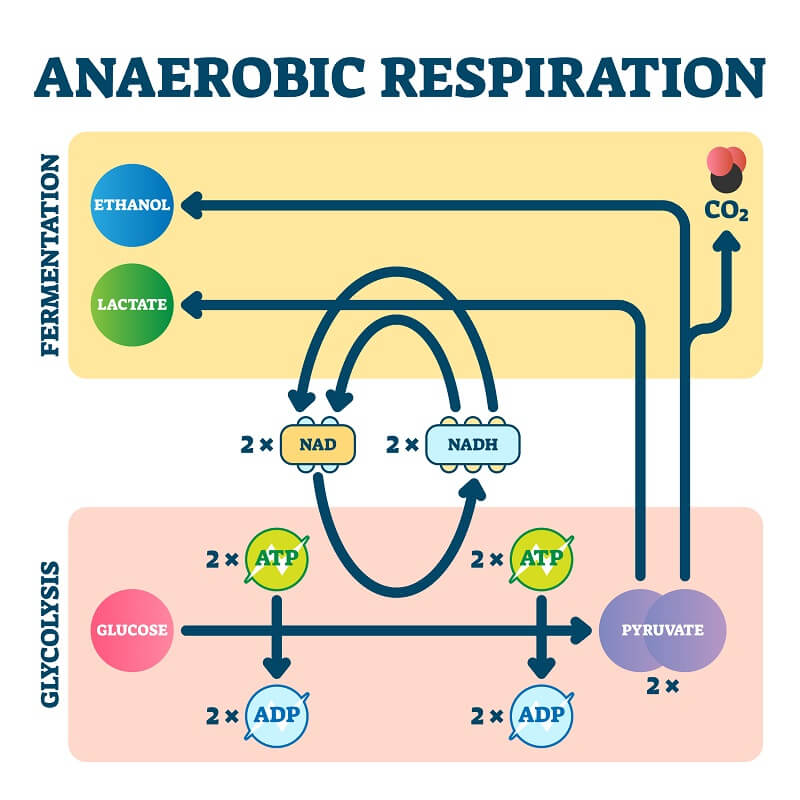Which Equation Best Describes a Method of Anaerobic Respiration
Aerobic respiration is the most efficient way to create energy in cells but it is not the only option. The equation for aerobic respiration is shown below.

Benchmark Review Questions Focus I Ppt Download
Aerobic respiration is a process that.

. As the cells run out of oxygen they switch to anaerobic respiration which allows the cell to make small amounts of ATP in the absence of oxygen. Anaerobic respiration describes how ATP breaks down glucose to form either lactate in animals or ethanol in plants and microorganisms. Glucose ethanol carbon dioxide.
The production of lactic acid and its buildup is the main reason why our muscles become weak and pain after exertion. Anaerobic Respiration Equation. Carbon dioxide and water.
As the cells run out of oxygen they switch to anaerobic respiration which allows the cell to make small amounts of ATP in the absence of oxygen. Physical activity that increases heart and breathing rates B. It is a distinct process from aerobic respiration.
Anaerobic respiration in plants and fungi C6H12O6 2C2H5OH 2CO2 energy Glucose Ethanol Carbon dioxide Anaerobic respiration in animals C6H12O6 2C3H6O3 energy Glucose Lactic Acid energy. The main steps of aerobic respiration are as follows. The link reaction in which the 3-carbon pyruvate molecules undergo a series of different reactions.
Thus less energy is. Mitochondria in aerobic respiration cytoplasm occurs while anaerobic respiration only. Anaerobic respiration usually occurs in lower plants and microorganisms.
Photosynthesis takes place in the mitochondria. C 6 H 12 O 6 2C 2 H 5 OH 2C0 2. Which equation best describes photosynthesis.
As the cells run. Which equation best describes aerobic respiration. These molecules have a lower reduction potential than oxygen.
C 6 H 12 O 6 6O 2 6H 2 O 6CO 2 ATP. Instead molecules such as sulfate SO 4 2- nitrate NO 3 or sulfur S are used as electron acceptors. Instead sulfate nitrate or sulfur is used.
Glucose oxygen carbon dioxide water energy released You need to be able to recognise the chemical symbols. This method still incorporates the respiratory electron transport chain but without using oxygen as the terminal electron acceptor. Answer 1 of 2.
Glucose and oxygen yield lactic acid and water. Respiration is the biochemical process in which the cells of an organism obtain energy by combining oxygen and glucose resulting in the release of carbon dioxide water and ATP the currency of. Anaerobic Respiration Glucose Alcohol Carbon dioxide Energy.
Which of the following is the best definition of anaerobic respiration. Glucose and oxygen yield energy carbon dioxide and water. The word equation for aerobic respiration is.
The results demonstrated that the antibiotic method was able to reduce pathogen counts by 79 and the FOP method was able to decrease. The waste product of photosynthesis is carbon dioxide. Anaerobic respiration in yeast is used during brewing and bread-making.
Anaerobic respiration is the ability of an organism to produce energy in the form of Adenosine Triphosphate ATP without using oxygen. The waste product of cellular respiration is oxygen. Glycolysis involves the splitting of a single 6-carbon glucose molecule into two 3-carbon pyruvate molecules.
Cellular respiration takes place in the chloroplasts. The anaerobic respiration is the oldest method of cellular respiration. The waste products of aerobic respiration are.
Whenever we perform intense physical exercises our muscles use anaerobic respiration and produces lactic acid. The chemical equation for aerobic respiration is glucose oxygen gives carbon dioxide water energy whereas the equation for anaerobic respiration is glucose giving lactic acid energy. In the absence of oxygen the glucose derived from food is broken down into alcohol and carbon dioxide along with the production of energy.
The process of cellular respiration releases energy. Anaerobic respiration is a process that takes in plants and animals and is equivalent to. Which equation best describes a method of anaerobic respiration.
Some examples of anaerobic respiration include alcohol fermentation lactic acid fermentation and in decomposition of organic matter. Anaerobic respiration is the formation of ATP without oxygen. Notice that along with glucose oxygen is a substrate of aerobic respiration.
Glucose yields energy and lactic acid. The chemical equation of aerobic respiration is as given below- Glucose C 6 H 12 O 6 Oxygen 6O 2 Carbon-dioxide 6CO 2 Water 6 H 2 O Energy ATP According to the above-given chemical equation energy is released by splitting the glucose molecules with the help of. Glucose enzymes carbon dioxide ethanol.
This leads to the formation of acetyl coenzyme A which has two carbons. Glucose ethanol or lactic acid carbon dioxide energy C6H12O6 2C2H5OH 2CO2 2ATP. The process of photosynthesis stores energy.
The cellular process that converts solar energy to chemical energy. Anaerobic respiration occurs in the cytoplasm a thick fluid surrounding organelles of the cell and involves two stages.

Anaerobic Respiration The Definitive Guide Biology Dictionary

Easy Method For Making A Photosynthesis Concept Map With Example Photosynthesis Concept Map Photosynthesis Activities

Benchmark Review Questions Focus I Ppt Download

Which Equation Best Represents The Aerobic Respiration Reaction Brainly Com
Comments
Post a Comment